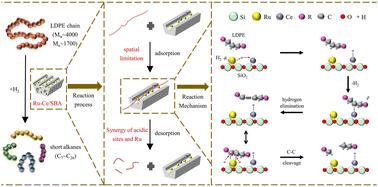Synergistic effect of acidic sites and mesoporous confinement in Ce-doped Ru/SBA-15 catalysts for efficient hydrogenolysis of low-density polyethylene to liquid fuels†
IF 4.2
3区 化学
Q2 CHEMISTRY, PHYSICAL
引用次数: 0
Abstract
The chemical upcycling of waste plastics into liquid fuels offers a promising approach to mitigating plastic pollution and reducing reliance on fossil resources. However, optimizing product distribution while enhancing the efficiency of hydrogenolysis remains a significant challenge. Herein, we report a multifunctional Ru-Ce/SBA-15 catalyst, which features uniformly dispersed Ru nanoparticles embedded within the mesoporous channels of SBA-15 via precise impregnation, and additional acidic sites introduced by Ce doping. Under optimized conditions (280 °C, 35 bar H2), the catalyst achieves an exceptional low-density polyethylene (LDPE) conversion rate of 939 gp gRu−1 h−1 and produces a narrow hydrocarbon range (C8–C25) ideal for liquid fuels. Comparative screening experiments demonstrate that the Ru-Ce/SBA-15 catalyst significantly outperforms commercial Ru, Pt, and Pd catalysts. Mechanistic investigations reveal that Ru within the mesopores facilitates hydrogen activation and C–C bond cleavage, whereas Ce doping enhances acidity, leading to controlled polymer chain scission and enhanced selectivity. The synergistic effect of acidic sites and mesoporous confinement, along with robust stability over multiple cycles, provide a solid theoretical foundation for designing next-generation catalysts for sustainable waste-to-fuel technologies.

ce掺杂Ru/SBA-15催化剂中酸性位点和介孔约束对低密度聚乙烯高效氢解制液体燃料的协同作用
废塑料的化学升级回收为液体燃料提供了一种有希望的方法来减轻塑料污染和减少对化石资源的依赖。然而,如何在提高氢解效率的同时优化产品分布仍然是一个重大的挑战。本文报道了一种多功能Ru-Ce/SBA-15催化剂,其特点是通过精确浸渍将均匀分散的Ru纳米颗粒嵌入SBA-15的介孔通道中,并通过Ce掺杂引入了额外的酸性位点。在优化条件下(280°C, 35 bar H2),催化剂实现了939 gp gRu−1 h−1的低密度聚乙烯(LDPE)转化率,并产生了理想的液体燃料的窄碳氢化合物范围(C8-C25)。对比筛选实验表明,Ru- ce /SBA-15催化剂明显优于商用Ru、Pt和Pd催化剂。机制研究表明,Ru在介孔内促进氢活化和C-C键的裂解,而Ce的掺杂增强了酸性,导致聚合物链断裂控制和选择性增强。酸性位点和介孔限制的协同效应,以及在多个循环中的强大稳定性,为设计下一代可持续废物转化为燃料技术的催化剂提供了坚实的理论基础。
本文章由计算机程序翻译,如有差异,请以英文原文为准。
求助全文
约1分钟内获得全文
求助全文
来源期刊

Catalysis Science & Technology
CHEMISTRY, PHYSICAL-
CiteScore
8.70
自引率
6.00%
发文量
587
审稿时长
1.5 months
期刊介绍:
A multidisciplinary journal focusing on cutting edge research across all fundamental science and technological aspects of catalysis.
Editor-in-chief: Bert Weckhuysen
Impact factor: 5.0
Time to first decision (peer reviewed only): 31 days
 求助内容:
求助内容: 应助结果提醒方式:
应助结果提醒方式:


